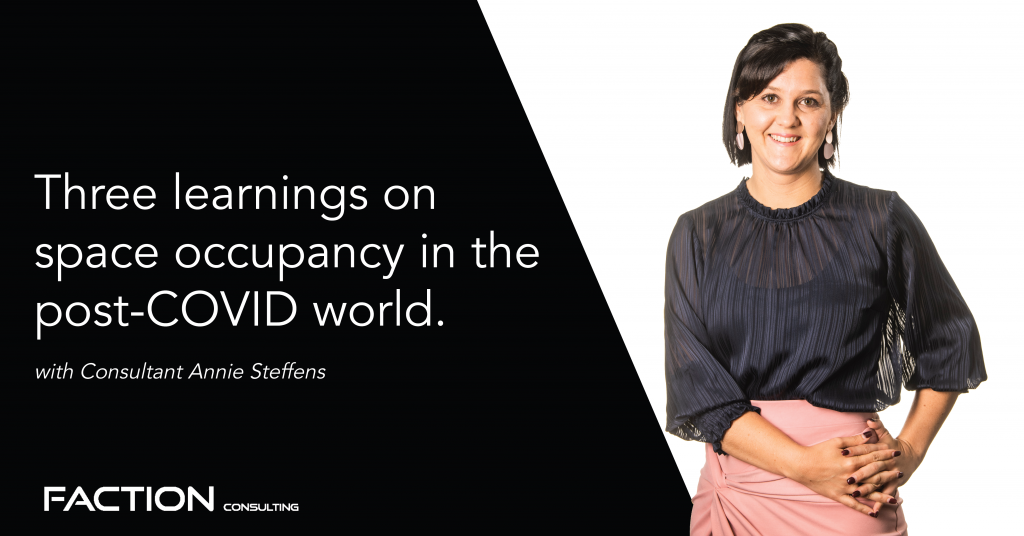Three learnings on space occupancy in the post-COVID world.
By FACTION Consulting
Whilst only months ago many industries were heralding in ‘The New Normal’ in a post-COVID climate, the recent lockdowns have reminded us that the path out of this pandemic is a challenging and long one. Flexibility and resilience remain key for workers and businesses to keep operations running smoothly, and this new driver for innovation has had a huge impact on the workplace sector.
For employers, it has forced innovation in the realms of communication, employee pastoral care, flexibility, and technology. Many of these innovations have been positive and have accidentally answered the call of countless workers who fought for greater accessibility and flexibility pre-pandemic.
Conversely, some workers have experienced the compounding of their home life and work life, as ‘the office’ can now be ‘anywhere’. Many of these challenges presented in the transition to remote working are strategies that already sit at the heart of change management services within the commercial workplace.
Consultant Annie Steffens is a specialist in tenant advisory and transition management at FACTION Consulting. As part of our FACTION Insights series, Annie has penned her thoughts on managing space occupancy strategy in a pandemic reality.
From March to August 2020, the workplace landscape changed immensely. Twelve months on, organisations around Australia are continuing to juggle the pressures of business-as-usual operations while adjusting to office contact tracingand ensuring safety and optimal hygiene standards are met and maintained. Organisations remain cautious to make firm decisions around their workplace strategy as the ‘new normal’ predicted for post-pandemic life is yet to settle in.
While assisting clients with their commercial real estate and workplace strategy and delivery during this period, we have identified three learnings on space occupancy that are applicable to occupiers across sectors.
Ask the longevity question at ‘U-turn moments’
Upcoming lease expiries, projects in the planning phase, and pending strategic portfolio decisions are examples of ‘U-turn moments’.
A ‘U-turn moment’ demands asking the big questions. It is the place to turn in the road and the perfect opportunity to make enquiries that look ahead of immediate bottom line to identify where, and how, to change direction and enhance property outcomes.
As business leaders are in agreement that the way of working has changed and flexible working looks like it is in to stay, one reoccurring question being posed is “is it time to downsize physical presence and reduce office space?”
In answering this question, organisations need to consider if the work-from-home style is efficient for your business, if downsizing aligns with your current growth strategy, and if the benefits of downsizing outweigh holding on to office space when considering the human-resources infrastructure needed to support a flexible work culture.
Align space occupancy strategy with culture and strategic objectives
Before swinging into action with any decisions taken at so-called ‘U-turn moments’, it is beneficial to look internally to identify the critical success factors for the health and wellbeing of your people, and continuity of your business.
By assessing the views of your workforce, you can then address potential impacts of space occupancy changes early to action a plan that balances ongoing and reliable operations with employee satisfaction.
While employee confidence in returning to the workplace during a pandemic may vary in sentiment, it will only be achieved through the widespread knowledge of sufficient, well-communicated, and visible measures designed to keep them safe.
Lean into digital solutions
Contact tracing and occupancy planning does not need to be a laborious task. The intensive demands of spreadsheets can be minimised through deployment of integrated property softwares – or ‘prop tech’.
The business case for introducing a space management technology into any organisation is multifaceted, with prop tech offering to help create smarter and more flexible workplaces with automated processes.
These modern space management technologies can be leveraged in a number of ways to help social distancing, such as ensuring employees are located appropriately in segregated zones, seat and desk management, flagging desks for cleaning using sensors, and even suggesting flow of employees using AI.
When evaluating software options, start by looking at your current solution and assess the level of additional support required to help achieve business objectives and promote a productive and healthy culture. A big bonus of current timing is the proliferation of start ups and new technology flooding the market, hence lowering price and improving the accessibility of solutions. From experience, the space occupancy technology that is most accessible to all employees, and not just a select coordinator, is the one with the greatest impact
A final word
In spite of its uncertainty, the global pandemic has presented the property industry with an enormous opportunity for innovation. As such, accessing technology solutions to ride the COVID storm, while taking a bold approach to future-forming workplace decisions doesn’t seem like a bad place to start.
Yes, it is an extremely challenging time for facilities management and heads of property alike, but the task at hand is clear: be flexible to stay ahead.
Change isn’t always bad after all.

